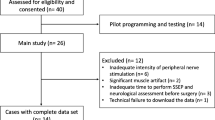Summary
With the intention of estimating the extent and site of damage in brachial plexus injuries which involve close to the root outlet and also the distal portion, cortical somatosensory evoked potentials (SEP) were recorded in 21 patients by directly stimulating the exposed brachial plexus. In 38 avulsed nerve roots which showed positive sensory action potentials (SNAP)/nerve action potentials (NAP) in their peripheral part, 15 roots (nine patients) were apparently in continuity and confirmed as root avulsion injury by the absence of cortical SEP. However, 11 roots (ten patients) which showed neither SNAP nor SEP would suggest either extensive lesions involving root and more distal segment or a combination of root avulsion and postganglionic injury. Fourteen patients who showed a positive Tinel's sign had at least one root with a postganglionic type lesion, but cortical SEP evoked by stimulation of the most proximal root zone sometimes revealed a reduced amplitude and prolonged latency. This would indicate the retrograde extension of damage. To confirm the extent and degree of the nerve lesions in brachial plexus injuries, an intraoperative SEP and NAP recording is very useful, practical, and also indispensable.
Zusammenfassung
Zur Schätzung des Grades und der Lokalisation der Armplexusverletzungen, die entweder in der Nähe des Austrittspunkts der Nervenwurzel oder weiter distal stattfand, waren die mit einer somatosensorischen Reizung erregten Hirnrindenaktions-potentiale abgeleitet und aufgezeichnet wurden. Anhand der 21 Patienten wurden die Armgeflechte ausgesetzt und direkt elektrisch stimuliert. Unter 38 ausgerissenen Nervenwurzeln, die positives sensorisches Aktionspotential in ihren peripheren Teilen zeigten, waren 15 Wurzeln (neun Patienten) scheinbar in Kontinuität, wurden jedoch wegen der Negativität des sensorisch erregten Rindenpotentials als Wurzelausriß-typverletzung bestimmt. Im Gegenteil, 11 Nervenwurzeln (zehn Patienten), die weder somatosensorisches Rindenaktionspotential noch sensorisches Nervenaktionspotential zeigten, würden entweder ausgedehnte Schädigungen an der Wurzel und mehr distalen Teilen oder eine Kombination von Wurzelausriß und postganglionischer Läsion vermuten lassen. Vierzehn Patienten, die ein positives Tinelsches Zeichen zeigten, hatten mindestens eine Wurzel mit einer postganglionischen Verletzung, oder ihr durch die Reizung der extrem proximalen Wurzel erregtes Rindenaktionspotential zeigte öfters eine reduzierte Schwingungsweite und eine Verzögerung der Latenzzeit. Dies würde auf eine retrograde Extension der Läsion hinweisen. Die intraoperative somatosensorische Rindenpotentialsleitung ist ein sehr wertvolles, praktisches und auch unentbehrliches Verfahren, um den Grad und die Lokalisation der Armplexusverletzungen zu bestimmen.
Similar content being viewed by others
References
Alnot JY (1977) Paralysie traumatique du plexus brachial chez l'adulte. Rev Chir Ortop 63:17–125
Bonney G (1954) The value of axon responses in determining the site of lesion in traction injuries of the brachial plexus. Brain 77:588–609
Bonney G, Gilliatt RW (1958) Sensory nerve conduction after traction lesion of the brachial plexus. Proc Roy Soc Med 51:365–367
Buchthal F, Rosenfalck A (1966) Evoked action potentials and conduction velocity in human sensory nerves. Brain Res 3:1–122
Davies ER (1966) Myelography in brachial plexus injury. Br J Radiol 39:362–371
Desmedt JE, Noel P (1973) New developments in electromyography and clinical neurophysiology, vol 2. S Karger, Basel, pp 352–371
Giblin DR (1964) Somatosensory-evoked potentials in healthy subjects and in patients with lesions of the nervous system. Ann NY Acad Sci 112:93–142
Jones SJ (1979) Investigation of brachial plexus traction lesions by peripheral and spinal somatosensory evoked potentials. J Neurol Neurosurg Psychiat 42:107–116
Landi A (1980) The role of somatosensory-evoked potentials and nerve conduction studies in the management of brachial plexus injuries. J Bone Jt Surg 62-B:492–496
Millesi H (1977) Surgical management of brachial plexus injuries. J Hand Surg 2:367–379
Murphey et al (1947) Myelographic demonstration of avulsing injury of the brachial plexus. Amer J Roentgenol 58:102–105
Nagano A (1979) Brachial plexus injuries—Prognosis of postganglionic type. Orthop Surg (Japan) 30:1534–1536
Narakas A (1978) Surgical treatment of traction injuries of the brachial plexus. Clin Orthop Rel Res 133:71–90
Rosén I (1977) Cervical root avulsion-Electrophysiological analysis with electrospinogram. Scand J Plas Reconstr Surg 11:247–250
Sunderland S (1974) Mechanisms of cervical nerve root avulsion in injuries of the neck and shoulder. J Neurosurg 41:705–714
Tsuyama N (1969) Intercostal nerve transfer for traumatic brachial nerve palsy. Orthop Surg (Japan) 20:1527–1529
Trojaborg W (1976) Motor and sensory conduction in the musculocutaneous nerve. J Neurol Neurosurg Psychiat 39:890–899
Warren J (1969) Electromyographic changes of brachial plexus root avulsions. J Neurosurg 31:137–140
Zalis A (1970) Electrophysiologic diagnosis of cervical nerve root avulsion. Arch Phys Med Reh 51:708–710
Zvěřina E, Kredba J (1977) Somatosensory cerebral evoked potentials in diagnosing brachial plexus injuries. Scand J Rehab Med 9:47–54
Author information
Authors and Affiliations
Rights and permissions
About this article
Cite this article
Sugioka, H., Tsuyama, N., Hara, T. et al. Investigation of brachial plexus injuries by intraoperative cortical somatosensory evoked potentials. Arch. Orth. Traum. Surg. 99, 143–151 (1982). https://doi.org/10.1007/BF00379201
Received:
Issue Date:
DOI: https://doi.org/10.1007/BF00379201




